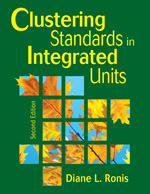Clustering Standards in Integrated Units
- Diane L. Ronis - Southern Connecticut State University, USA
Teaching Methods & Learning Styles
"This book provides a wealth of information for teachers who are seeking new ways to meet the needs of all learners for high academic achievement!"
—Marguerita K. DeSander, Assistant Professor of Leadership and Policy Studies
The George Washington University
"Using this book as part of the alignment process will greatly enhance any classroom curriculum!"
—Joen M. Painter, Education Consultant
Develop integrated, meaningful units that engage students and address multiple standards!
Using a student-oriented approach, Clustering Standards in Integrated Units, Second Edition, offers guidelines for designing interdisciplinary units that combine content areas, address standards, and involve students in their own learning and assessment.
Diane L. Ronis offers a framework for organizing, implementing, and evaluating units and provides sample rubrics, templates, and reproducibles for the planning process. Drawing on a constructivist approach and geared to meet students' individual learning needs, the text demonstrates how to:
- Integrate content across multiple curriculum areas
- Make instruction meaningful using new information about how the brain works
- Encourage students to pose and investigate questions relevant to the real world
- Access specific Web sites for meeting state standards
This book helps seasoned and novice teachers facilitate collaborative learning with teams of students and assist them in making significant connections between their own experiences and events in the real world.
"This book provides a wealth of information for teachers who are seeking new ways to meet the needs of all learners for high academic achievement!"
"Utilizing this book as part of the alignment process will greatly enhance any classroom curriculum!"
"This resource is easy to use, a quick read, and contains many useful graphics and rubrics."
"From sample rubrics and reproducibles to understanding how to meet individual student learning needs—and how to empower them to choose the right paths—this book is an excellent choice for experienced or new teachers who want to encourage collaborative student learning styles."
